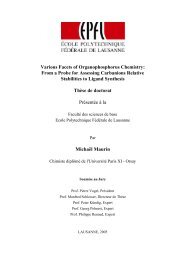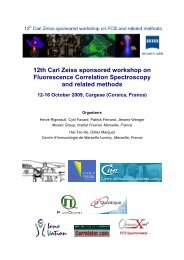GratinGs: theory and numeric applications - Institut Fresnel
GratinGs: theory and numeric applications - Institut Fresnel
GratinGs: theory and numeric applications - Institut Fresnel
Create successful ePaper yourself
Turn your PDF publications into a flip-book with our unique Google optimized e-Paper software.
11.2 Gratings: Theory <strong>and</strong> Numeric Applications, 2012<br />
could start giving an overview of the activities that took place during the years to follow the<br />
great physics advances of a century ago. Here we focus on the research that has been generally<br />
referred to as the <strong>theory</strong> of homogenization, starting from the early 1970s. Of course, even at<br />
that point it was not, strictly speaking, the beginning of the subject, but we will use this period<br />
as a kind of reference point in this survey.<br />
The question that a mathematician may pose in relation to the perceived concept of “averaging<br />
out” the detailed features of a heterogeneous structure in order to get a more homogeneous<br />
description of its behaviour is the following: suppose that we have the simplest possible linear<br />
elliptic partial differential equation (PDE) with periodic coefficients of period η > 0. What is<br />
the asymptotic behaviour of the solutions to this PDE as η → 0? Can a boundary-value problem<br />
be written that is satisfied by the leading term in the asymptotics, no matter what the data<br />
unrelated to material properties are? Several research groups became engaged in addressing<br />
this question about four decades ago, most notably those led by N. S. Bakhvalov, E. De Giorgi,<br />
J.-L. Lions, V. A. Marchenko, see [2], [3], [4], [5] for some of the key contributions of that<br />
period. The work of these groups has immediately led to a number of different perspectives<br />
on the apparently basic question asked above, which in part was due to the different contexts<br />
that these research groups had had exposure to prior to dealing with the issue of averaging.<br />
Among these are the method of multiscale asymptotic expansions (also discussed later in this<br />
chapter), the ideas of compensated compactness (where the contribution by L. Tartar <strong>and</strong> F.<br />
Murat [6], [7] has to be mentioned specifically), the variational method (also known as the “Γconvergence").<br />
These approaches were subsequently applied to various contexts, both across<br />
a range of mathematical setups (minimisation problems, hyperbolic equations, problems with<br />
singular boundaries) <strong>and</strong> across a number of physical contexts (elasticity, electromagnetism,<br />
heat conduction). Some new approaches to homogenization appeared later on, too, such as the<br />
method of two-scale convergence by G. Nguetseng [8] <strong>and</strong> the periodic unfolding technique by<br />
D. Cioranescu, A. Damlamian <strong>and</strong> G. Griso [9]. Established textbooks that summarise these<br />
developments in different time periods, include, in addition to the already cited book [4], the<br />
monographs [10], [11], [12], <strong>and</strong> more recently [13]. The area that is perhaps worth a separate<br />
mention is that of stochastic homogenization, where some pioneering contributions were made<br />
by S. M. Kozlov [14], G. C. Papanicolaou <strong>and</strong> S. R. S. Varadhan [15], <strong>and</strong> which has in recent<br />
years been approached with renewed interest.<br />
A specific area of interest within the subject of homogenization that has been rapidly developing<br />
during the last decade or so is the study of the behaviour of "non-classical" periodic<br />
structures, which we underst<strong>and</strong> here as those for which compactness of bounded-energy solution<br />
sequences fails to hold as η → 0. The related mathematical research has been strongly<br />
linked to, <strong>and</strong> indeed influenced by, the parallel development of the area of metamaterials <strong>and</strong><br />
their application in physics, in particular for electromagnetic phenomena. Metamaterials can<br />
be roughly defined as those whose properties at the macroscale are affected by higher-order behaviour<br />
as η → 0. For example, in classical homogenization for elliptic second-order PDE one<br />
requires the leading (“homogenised solution”) <strong>and</strong> the first-order (“corrector”) terms in the ηpower-series<br />
expansion of the solution in order to determine the macroscopic properties, which<br />
results in a limit of the same type as the original problem, where the solution flux (“stress”<br />
in elasticity, “induction” in electromagnetics, “current” in electric conductivity, “heat flux” in<br />
heat conduction) depends on the solution gradient only (“strain” in elasticity, "field" in electromagnetics,<br />
“voltage” in electric conductivity, “temperature gradient” in heat condiction). If,<br />
however, one decides for some reason, or is forced by the specific problem setup, to include<br />
higher-order terms as well, they are likely to have to deal with an asymptotic limit of a different













